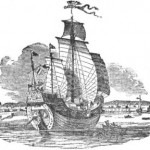CONF: The Itineraries of Art Topographies of Artistic Mobility in
Europe and Asia 1500-1900
Annual Conference of the DFG Research Unit 1703 Transcultural Negotiations in the Ambits of Art. Comparative Perspectives on Historical Contexts and Contemporary Constellations
Organized by Project Area B Transgressive Itineraries and Transcultural Aesthetics of Artistic Exchange in cooperation with the DFG Research Project Landscape, Canon and Intermediality in Chinese Painting of the 1930s and 1940s
Venues: Freie Universität Berlin, Kunsthistorisches Institut, Koserstraße 20, 14195 Berlin, Hörsaal B (Lecture Hall)Museen Dahlem, Lansstraße 8, 14195 Berlin, Großer Vortragssaal (Large
Auditorium)
The conference discusses the interaction between routes as channels of communication and as modes of artistic experience in Europe and Asia. While recent scholarship has devoted attention to the economic and political historiographies of road-systems, this conference will focus
on routes as stimuli of cultural transfer and artistic production. Addressing interactive overland and maritime networks as itineraries of contact and catalysts of artistic exchange will underscore the cultural agency of routes and interconnections. Framed in the historiography of longue durée, routes may be addressed as trajectories that cut across culturally determined geographies and periodizations. The conference concentrates on the sixteenth through nineteenth centuries and thereby foregrounds a period characterized by the unprecedented expansion and transformation of pre-existent route-networks. In the wake of the first global circumnavigation in 1522, the connection of overland-roads and maritime routes triggered new dynamics of transcontinental
entanglements.
The conference aims at parallel perspectives on both Western Europe and East Asia, geographical regions that imagined each other as ›natural‹ terminus points of the ancient Eurasian trade networks. Consequently, new combinations of transcontinental telluric and nautical routes profoundly affected such predominant cultural topographies and symbolic paradigms. The rise of Asian and European port cities as nodes of maritime systems and prosperous cultural contact zones, often at the expense of inland metropoles, bespeaks this fundamental shift. By the end of the nineteenth century this process entered its end-stages; it is hardly coincidental that in this period, marked by colonialism and nationalism, some of the most enduring narratives of pre-modern routes evolved. To relate the proliferation of routes in the Early Modern era to art and artistic practices is also to engage with not only the actual translocation of persons, animals and objects, but with protocols and mechanisms of control and constraint. Furthermore, it is crucial to pose the question of how the visual arts in diverse historical and cultural contexts contributed to the fabrication of collective imaginations about routes past and present, as well as long-distance journeys. Parallel enquiries of practices and tropes of artistic mobility in Western Europe and East Asia enable the reconsideration of previously separate research in the agency of routes pursued at the intersection of the histories of art, cross-cultural transfer and entanglement.
Programme
Thursday, 23 May 2013
Freie Universität Berlin, Kunsthistorisches Institut, Hörsaal B
18:00 Gregor Stemmrich (Berlin), Opening
18:15 Karin Gludovatz (Berlin), Joachim Rees (Berlin), Introduction
18:30 Christian Kravagna (Vienna), When Routes Entered Culture:
Histories and Politics of Transcultural Thinking
Friday, 24 May 2013
Museen Dahlem, Large Auditorium
09:30 Klaas Ruitenbeek (Museum für Asiatische Kunst, SMB), Welcome
Remarks
Art/Histories of Routes – A Transcultural Paradigm?
09:45 Joachim Rees (Berlin), Introduction
10:00 Monica Juneja (Heidelberg)
Tracking the Routes of Vision in Early Modern Eurasia
11:00 Michael North (Greifswald)
Tracking European and Chinese Objects of Art in the Indian Ocean (17th
and 18th Centuries)
12:00 Lunch Break
13:30 Eugene Wang (Cambridge, MA)
Why was there no Chinese Painting of Marco Polo? The Limits of
Itinerancy-Themed Art Historical Inquiry
14:30 Melanie Trede (Heidelberg)
Sea Routes to the Mainland: Identity Politics and the Formation of a
Cultural Memory in Japanese Pictorial Narratives
15:30 Coffee Break
Symbolic Itineraries and Topographies – Framing Roads and Routes
16:00 Juliane Noth (Berlin), Introduction
16:15 Evelyn Reitz (Berlin)
Transcultural Ballast. Netherlandish Tiles as Vehicles of Exchange
17:15 Sophie Annette Kranen (Berlin)
The Historicity of the Route in the ›Atlas‹ of James Cook’s Third Voyage
Saturday, 25 May 2013
Museen Dahlem, Large Auditorium
10:00 Elizabeth J. Kindall (St. Paul)
Geo-Narrative in Seventeenth-Century China
11:00 Julia Orell (Zürich)
The River as Personal Itinerary and Painting Lineage: Ten Thousand
Miles along the Yangzi in Late Ming and Early Qing China
12:00 Lunch Break
Crossroads, Hubs and Centers – Art Forms of Interaction
13:30 Evelyn Reitz (Berlin), Introduction
13:45 Jessica Stewart (Munich)
Accomodating Exotica, Incorporating Strangers: Displacement,
Domestication and the Antwerp Market
14:45 Joachim Rees (Berlin), Nora Usanov-Geißler (Berlin)
Harboring Expectations. The Littoral as Contact Zone in the Visual Arts
of Japan and the Netherlands (ca 1570-1630)
15:45 Coffee Break
16:15 Yu-Chih Lai (Taipei)
Court and Cultural Exchanges: A Study of the ›Album of Birds‹ Produced
at the Qing Qianlong Court
17:15 Ulrike Boskamp (Berlin)
Art, Topography and Identity in a Military Hub: Representing the
Portsmouth Area in the Revolutionary and Napoleonic Wars
18:30 End of Conference


Leave a Reply
You must be logged in to post a comment.